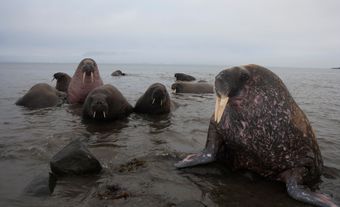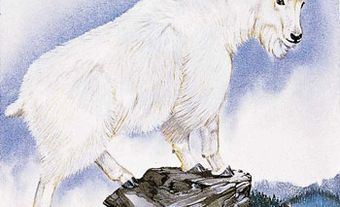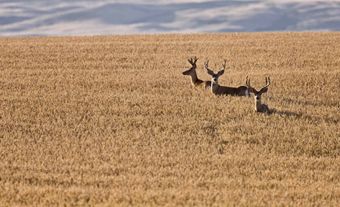
Key Terms
|
Cow |
An adult female moose. |
|
Bull |
An adult male moose. |
|
Dewlap |
A flap of skin hanging from the neck of some animals, including moose. |
Description
Moose have a dark coat that varies from blackish to dark brown and comparatively light- coloured faces. Bulls’ faces darken around mid-August as testosterone levels increase in advance of the upcoming breeding season. Moose have long legs that are useful for navigating the various obstacles found throughout their range (e.g. snow, logs, and water), and a pronounced hump at the shoulder. Bones in the hump connect with muscle and tendons to support a heavy head and antlers (in bulls). Mature cows in prime condition may weigh up to 545 kg and bulls can reach close to 750 kg.
Bulls grow antlers and cows do not. Each antler is referred to as a “palm,” with a larger, main palm at the top and a smaller, brow palm protruding forward. Antlers come in two different shapes: full palm and split palm. In split palm antlers, there is an indentation between the main and brow palms, and in full palm antlers, there is not.
Antlers usually begin growing in April, and by mid-July growth is about 80 per cent complete. From this point onward the antlers harden, and in early September the velvet covering them begins to shed. In November, the antlers begin to fall off. Antlers are occasionally used for fighting between animals of the same social rank when they’re competing for cows. However, those with large antlers can usually fend off rivals by simply displaying their antler size and posturing.
Additional interesting features include the moose’s overhanging upper lip, large ears and dewlap (bell) hanging from the throat. Dewlaps are more robust in bulls than cows, and include a rope-like piece of skin hanging down from the bell. With age, the rope portion usually falls off. Cows can be identified by the white vulva patch just below the anus. This patch is useful in determining the sex of animals during aerial surveys, since during the winter, bulls (like cows) do not have antlers.
Distribution and Habitat

In Canada, moose inhabit the boreal forest from Newfoundland (introduced) and the Québec-Labrador Peninsula, through Nova Scotia and New Brunswick, west to British Columbia and north to the Arctic Ocean in Alaska. Called elk in Europe, they range from northern Asia to Scandinavia.
Moose are often found in areas where logging or a recent forest fire has occurred, as they prefer the new vegetation found in these places.
Diet
Moose browse in winter on the new growth of balsam fir, as well as the twigs of deciduous trees such as birch, aspen, willow, red osier dogwood and hazel. During the summer season, moose primarily eat leaves and aquatic plants. They make use of mineral licks in spring through early autumn. Natural mineral licks that contain high mineral salt concentrations can be found in swamps, springs and mud. Salt deposits on roadsides (the result of salt being spread in the winter) are also visited.
Reproduction and Development

Moose breeding season, sometimes referred to as “the rut,” includes a series of behavioural and physiological changes that start in mid-August. Breeding takes place from mid-September and, for the most part, is complete by about the second week of October. During the breeding season, cows are quite vocal with a loud, drawn out call and bulls, when searching for receptive cows, use a low, deep, guttural grunt. A few cows will breed when they are one and half years old, but once they reach the fall after their second birthday all cows have usually bred. The gestation period is about 230 days and calves are born in the spring. Newborns generally weigh 12-16 kg, and are reddish-brown; they are hidden in secluded places when the mother forages.
During the breeding season, bull urine takes on a pungent odour. Bulls make a shallow hole and urinate into it, then vigorously pound their front feet into the hole, splashing urine onto their head, bell and the underside of their antlers. Cows wet their noses with the urine, lie in the shallow hole, or nuzzle the bull’s bell. Research suggests that the urine synchronizes the cows’ ovulation.
Relationship with Humans
Moose are a traditional food source for Indigenous peoples living within the animal’s range. In Eastern Canada these groups include the Abenaki, Wolastoqiyik, Mi’kmaq and Algonquin; in central Canada and into the Plains—the Huron-Wendat, Ojibwe, Cree and Dakota; from the Plains into Western Canada—the Siksika, Ktunaxa and Interior Salish; along the Northwest Coast—the Tlingit, Nuxalk, Nisga’a, Tsimshian and Nuu-chah-nulth; in the Subarctic—the Dene First Nations; in the Arctic—the Inuit; and in various parts of Canada—the Métis. Moose are generally hunted in late summer and early fall, as well as in late winter and early spring. How the animals are harvested depends on the group; some, such as the Mi’kmaq, travel in order to hunt, while those in the Algonquian cultural group are said to hunt on land owned by individual families. For most Indigenous peoples, hunting is primarily a male activity; however, among the Ktunaxa, for example, the entire family participated in the moose hunt.
Moose are also hunted by non-Indigenous people according to guidelines set out by each province and territory. In some provinces, motorists pose a problem for the animals. In the spring, yearlings begin to wander without the direction of their mothers and moose of all ages are attracted to roadside vegetation and the salt left over from winter. In New Brunswick, for example, about 400 moose are killed by motorists each year, with the majority of these collisions occurring in the spring and summer.
Challenges

Logging and mining activities bring increased access to formerly inaccessible moose habitats, facilitating better access by hunters and predators. Climate change is an ongoing concern and brings with it increased risk of disease. For example, despite their name, winter ticks (Dermacentor albipictus) are associated with warmer weather. Tens of thousands of these ticks may use a single moose as their host, feeding off the animal’s blood, negatively affecting the moose’s behaviour, weight, blood levels, and reproductive health. Calves are especially vulnerable, and high death rates are being seen. As well, moose in poor health have trouble fending off predators.
Similarly, the northward movement of white-tailed deer—due to warmer weather—is a major concern, as they carry a brain parasite which can kill moose. As moose populations decline, predators such as bears and wolves focus on calves during the calving season, making it additionally difficult for moose to replenish their numbers.

 Share on Facebook
Share on Facebook Share on X
Share on X Share by Email
Share by Email Share on Google Classroom
Share on Google Classroom




